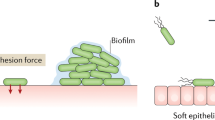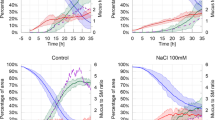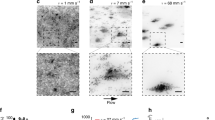Abstract
Using laminar flow chambers and time-lapse video imaging, colonization of surfaces by four marine bacteria revealed a diverse range of morphological characteristics and cell-cell interactions. The strain SW5 formed a compact, multilayered single- and double-cell biofilm on hydrophobic surfaces but developed long multicellular chains on hydrophilic surfaces. The morphologically similar SW8 showed unusual proximal vertical packing of cells on both substrata.Vibrio sp strain S14 exhibited cyclical colonization-detachment events on both substrata.Pseudomonas sp strain S9 initially displayed reversible and then irreversible adhesion apparently triggered by a cell density phenomenon that led to the development of regular microcolonies on both substrata with individual cells translocating between the colonies. The length of time bacteria were exposed to and their density at a surface influenced behavioral traits, with diverse and distinctive species-specific behavioral events.
Similar content being viewed by others
References
Angles ML, KC Marshall and AE Goodman. 1993. Plasmid transfer between marine bacteria in the aqueous phase and biofilms in reactor microcosms. Appl Environ Microbiol 59: 843–850.
Dalton HM, LK Poulsen, P Halasz, ML Angles, AE Goodman and KC Marshall. 1994. Substratum-induced morphological changes in a marine bacterium and their relevance to biofilm structure. J Bacteriol 176: 6900–6906.
Fattom A and M Shilo. 1984. Hydrophobicity as an adhesion mechanism of benthic cyanobacteria. Appl Environ Microbiol 47: 135–143.
Goodman AE and KC Marshall. 1995. Genetic responses of bacteria at surfaces. In: Bacterial Biofilms (Lappin-Scott H and JW Costerton, eds), pp. 80–98. Cambridge University Press, Cambridge, UK.
Humphrey B, S Kjelleberg and KC Marshall. 1983. Responses of marine bacteria under starvation conditions at a solid-water interface. Appl Environ Microbiol 45: 43–47.
Humphrey BA, MR Dickson and KC Marshall. 1979. Physiochemical andin situ observations on the adhesion of gliding bacteria to surfaces. Arch Microbiol 120: 231–238.
Jones GW and RE Isaacson. 1983. Proteinaceous bacterial adhesins and their receptors. Crit Rev Microbiol 10: 229–260.
Kjelleberg S, BA Humphrey and KC Marshall. 1982. Effect of interfaces on small, starved marine bacteria. Appl Environ Microbiol 43: 1166–1172.
Lawrence JR and DE Caldwell. 1987. Behavior of bacterial stream populations within the hydrodynamic boundary layers of surface microenvironments. Microbial Ecol 14: 15–27.
Lawrence JR, PJ Delaquis, DR Korber and DE Caldwell. 1987. Behavior ofPseudomonas fluorescens within the hydrodynamic boundary layers of surface microenvironments. Microbial Ecol 14: 1–14.
Lawrence, JR, DR Korber, GM Wolfaardt and DE Caldwell. 1995. Behavioral strategies of surface-colonizing bacteria. Adv Microbial Ecol 14: 24–26.
Marshall KC. 1985. Mechanisms of bacterial adhesion at solid-liquid interfaces. In: Bacterial Adhesion: Mechanisms and Physiological Significance (Savage DC and M Fletcher, eds.), pp. 133–161, Plenum Press, New York, NY.
Marshall KC and RH Cruickshank. 1973. Cell surface hydrophobicity and the orientation of certain bacteria at interfaces. Arch Microbiol 91: 29–40.
Marshall KC, R Stout and R Mitchell. 1971. Mechanism of the initial events in the sorption of marine bacteria to surfaces. J Gen Microbiol 68: 337–348.
McCoy WF and JW Costerton. 1982. Fouling biofilm development in tubular flow systems. Dev Ind Microbiol 53: 551–558.
McLean RJC and JC Nickel. Bacterial colonization behavior: a new virulence strategy in urinary infections? Medical Hypotheses 36: 269–272.
Neu TR and KC Marshall. 1991. Microbial ‘footprints’—a new approach to adhesive polymers. Biofouling 3: 101–112.
Östling JA, AE Goodman and S Kjelleberg. 1991. Behaviour of IncP-1 plasmids and a miniMu transposon in a marineVibrio sp: isolation of starvation induciblelac operon fusions. FEMS Microbiol Ecol 86: 83–94.
Power K and KC Marshall. 1988. Cellular growth and reproduction of marine bacteria on surface-bound substrate. Biofouling 1: 163–174.
Pringle JH, M Fletcher and DC Ellwood. 1983. Selection of attachment mutants during the continuous culture ofPseudomonas fluorescens and relationship between attachment ability and surface composition. J Gen Microbiol 129: 2557–2569.
Rosenberg E, A Gottlieb and M Rosenberg. 1983. Inhibition of bacterial adherence to hydrocarbons and epithelial cells by emulsan. Infect Immun 39: 1024–1028.
Schneider RP and KC Marshall. 1994. Retention of the Gram-negative marine bacterium SW8 on surfaces-effects of microbial physiology, substratum nature and conditioning films. Colloids and Surfaces B: Biointerfaces 2: 387–396.
Shapiro JA and C Hsu. 1989.Escherichia coli K-12 cell-cell interactions seen by time-lapse video. J Bacteriol 171: 5963–5974.
Siebel MA and WG Characklis. 1991. Observations of binary population biofilms. Biotech Bioeng 37: 778–789.
Swift S, NJ Bainton and MK Winson. 1994. Gram-negative bacterial communication by N-acyl homoserine lactones: a universal language. Trends Microbiol 2: 193–197.
Szewzyk U and B Schink. 1988. Surface colonization by and life cycle ofPelobacter acidigallici studied in a continuous-flow microchamber. J Gen Microbiol 134: 183–190.
Wrangstadh M, U Szewzyk, J Östling and S Kjelleberg. 1990. Starvation-specific formation of a peripheral exopolysaccharide by a marinePseudomonas sp, strain S9. Appl Environ Microbiol 56: 2065–2072.
Author information
Authors and Affiliations
Rights and permissions
About this article
Cite this article
Dalton, H.M., Goodman, A.E. & Marshall, K.C. Diversity in surface colonization behavior in marine bacteria. Journal of Industrial Microbiology & Biotechnology 17, 228–234 (1996). https://doi.org/10.1007/BF01574697
Received:
Accepted:
Issue Date:
DOI: https://doi.org/10.1007/BF01574697




